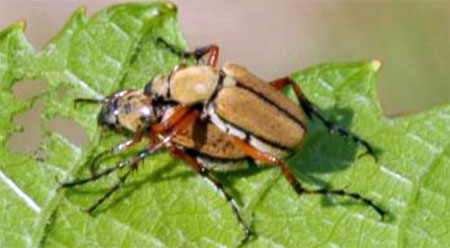Rose chafers are plentiful in 2011
A high population of rose chafers won’t cause harm to your turf, but can do some serious damage to your ornamental and crop plants.
The rose chafer, Macrodactylus subspinosus, is now appearing in large numbers in many areas of Michigan.The rose chafer, commonly known as scarabs, is a native insect and a member of the same family as June beetles. However, the adult rose chafer looks quite different from a June beetle. Adults are about 0.05 inches long, slender, usually light tan with long, reddish-brown legs. They are rather gangly in appearance. They are often found in mating pairs and fly during daylight hours and are not attracted to lights at night like June beetles. Adults contain a distasteful chemical; few birds can eat them without being sickened. The grub stage is typical of the entire family – a soft bodied, “C”-shaped white grub with six legs and a prominent brown head. There is a single generation per year with the adults showing up in June. The activity of adults typically lasts for only two to three weeks.

Photo credit: Duke Elsner, MSUE.
Adult rose chafers sometimes cause significant injury to plants, but their grubs are of almost no concern. Adult rose chafers feed on the foliage, buds, flowers and fruits of hundreds of plants; most notably in our area they are pests of wine grapes, cherries, apples, raspberries, strawberries, roses and peonies. They will also feed on the tender young foliage of many trees, especially sugar maple, chestnut and birch. They have weak jaws, so they typically eat only the most tender portions of leaves, resulting in irregular holes between the tougher leaf veins. They are strongly attracted to white flowers, so they will turn up first on roses or peonies with white blossoms or on the white petals of daisies. The period of adult flight lasts only a few weeks. They are good fliers and are capable of traveling great distances to find a meal.
The grub stage of the rose chafer feeds on plant roots, but they are typically found only in sandy open areas where wild grasses and weedy plants predominate. The grubs of rose chafers are not pests of lawn grasses and landscape plants like their June beetle cousins.
In most years, adult rose chafers are moderately annoying to the home gardener and they can be dealt with by hand-picking and the occasional use of insecticides. In high population years like this year, they can be serious pests of ornamental and crop plants, requiring pesticide sprays to protect plants from the voracious adults. Sprays may have to be applied frequently in order to protect plants from injury as it only takes a short time for a lot of feeding injury to occur when the adult population is high.
Treating lawns or gardens with grub control products will do nothing to reduce the numbers of rose chafers that attack in the adult stage as their grubs do not reside in landscaped areas.



 Print
Print Email
Email